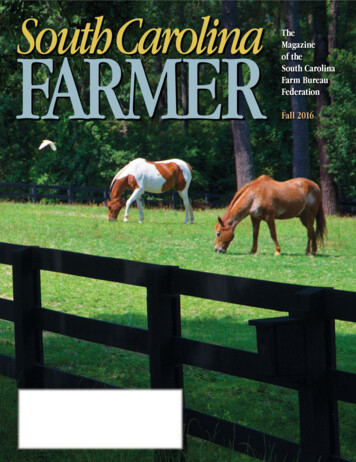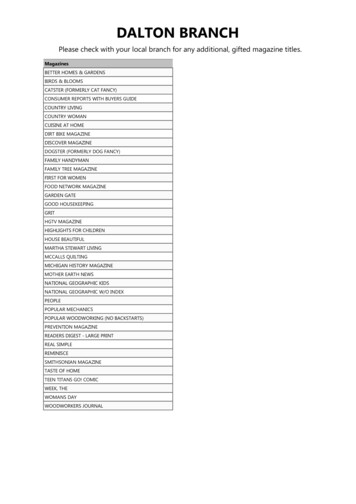
Transcription
TheMagazineof theSouth CarolinaFarm BureauFederationFall 2016South Carolina Farmer / Fall 2016ii
South Carolina’sBIGGESTCROP.In More Ways Than OneBy Larry ChesneyPhotography By Larry Kemmerlin8SouthSouthCarolinaCarolinaFarmerFarmer/ Summer/ Fall 2016
They’re all around us. Even in the suburbsand the cities, they’re scattered here and there,their branches reaching up to the skies, theirroots solidly entrenched in the earth. Trees. All shapesand sizes, they provide cool shade, clean air and water,natural beauty, and food for wildlife. But out in thecountry, away from the neighborhoods and tall buildings,broad expanses of trees provide much more. Thoseforests are big business in South Carolina.Gene Kodama is the director of the South CarolinaForestry Commission, or as the position is commonlyreferred to, the South Carolina State Forester. He’s beenthere since 2008, leading the agency that oversees thestate’s 13 million forested acres.South Carolina/ Fall20162016SouthCarolinaFarmerFarmer/ Fall9
Below: Russell Hubright (left), an advisor to FarmBureau’s Forestry Committee, and Billy Cate survey astand on Cate’s 1,200 forested acres that he managesfor timber production, wildlife, and aesthetics.10South Carolina Farmer / Fall 2016Below: Billy Cate pauses during his inspection of apine plantation.Opposite: Young longleaf pines sprout up in area thathad been clearcut several years earlier.
“Forestry is one of the largest industries in the state,” saysKadoma, “with a nearly 19 billion dollar impact and over 90,000jobs. It’s huge. As big as tourism. The forest industry and agriculturetogether total over 40 billion in economic impact. That’s largerthan any other industry grouping.“About 88 percent of the state’s forests is owned by privateindividuals,” he pointed out. “And two-thirds of this is owned byfamily forest landowners with an average acreage of 80 acres. Theseprivate lands produce about 95 percent of the wood that the state’stimber industry uses and it supports about 95 percent of the jobs.”Billy Cate of Eastover manages one of the many familyowned timber tracts in the state. His farm has beenproducing trees successfully for more than 65 years.“I’m a second generation tree farmer,” says Cate. “It was around1950 when my father enrolled in the Tree Farm program. He wasSouth Carolina Tree Farmer of the Year back in 1979.”Cate took over the farm some time back and was named the 2016Tree Farmer of the Year. “I’m a second generation legacy in thatcapacity,” he adds, “which is kind of cool.”The Cates have tried a variety of crops over the years, but forestryhas always paid the majority of their bills. One of the reasonsthey’ve been successful with their forestry is that they’ve had a longterm plan going in.“I think every landowner needs to prioritize what his goals arewhen managing a farm of any kind,” Cate notes. “In our case, ournumber one priority is timber production. Number two is wildlifemanagement. And number three is aesthetics. We would nevermake a management decision without considering all three.“For instance, we might not do a particular timber harvest thatmakes good economic sense simply because we don’t think it wouldlook good.”Cate says they take a lot of pride in the appearance of their 1,200acre farm. Of that area, 1,100 acres are in loblolly and longleaf pines,and a variety of hardwoods. The loblollysare intensively managed as a crop withregular thinnings and eventually, clearcuts.Cate realizes that another landownermight have different priorities. “They mightnot need the money,” he says. “It might notbe important to them.”Based on his priorities, his farm is rightwhere Cate wants it. “Our forest is selfsustaining, meaning we’re able to harvestsomething every year. It may be a thinning.It may be a clearcut. We always have timbertracts of different ages . . . always somethingready to be harvested.”While Cate handles the management of the farm, he trusts aprofessional forester to make most of the recommendations.“We spend a day per year riding through the farm, deciding whatthe next projects are going to be,” says Cate. “Whatever we decideto cut, the forester contacts timber buyers, and they contract alogger. The forester oversees the job to make sure it’s done right.And he makes sure I’m getting the right price. I’ve always felt it wasworth the expense to pay a professional to oversee that process.His commission more than pays for itself.”Charles Buist got his start in South Carolina’s forestryindustry in 1973. He retired from the International PaperCompany around eight years ago. Today, he manages hisown 110 acres of pine trees near Greenwood. And despite hisretirement status, Charles is a hands-on manager.“On my 110 acres I do what needs to be done myself,” he says. “Iplanted some trees in 2004 and some in ’09. I’ll probably wait untilthe first planting is 18 years old before I do any thinning.”Buist is president of the Greenwood County Farm Bureau and amember of the Farm Bureau Forestry Committee, so he stays on topof the industry in South Carolina.South Carolina FarmerFarmer // FallFall2016201611
“We have lobbyists in Washington and in Columbia to help makesure the Forestry Commission gets the funding they need to buyequipment, to fight wildfires, and to do replanting on clearcuts. Wejust want to see these tracts, large ones and small ones, planted inpines and put back into production.“Our main priorities,” Buist concludes, “are to keep the ClemsonExtension Service and the Forestry Commission going strong.”Reg Williams of Edgefield is co-owner of Log CreekTimber Company along with his brother and sister. “Mydad started in the timber business in ’84,” said Williams,“so our family has been in it for quite awhile.”Today they procure wood from individual landowners andcorporate landowners, then have it harvested and hauled to themills. Williams was an Ag-Econ major at Clemson and says none ofthem are “educated” foresters, but they have credentialed forestersworking for them.Williams is chairman of the South Carolina ForestryAssociation, which represents all aspects of the timber industry,from the landowners to the timber harvesters to the consultantsto the mill people.“We have different goals,” he explains, “but we work together tofight for the rights of the timber industry, which entails lobbyingplus watching rules and regulations that might affect the timberindustry. We want to make sure that we will always have healthy,abundant, and well-managed forests.“We also work hand-in-hand with other organizations like theSouth Carolina Forestry Commission and the Cooperative ClemsonExtension Service, as well as the South Carolina Department ofAgriculture, to support what they do. Things ranging from fightingwildfires to assisting forest landowners forthe betterment of forestry.”Williams goes on to say that SouthCarolina is unique in that it has a voluntaryrulebook of best management practices thatis implemented and supported by theindustry and monitored by the state’sForestry Commission.“In South Carolina, we do a great job offollowing these guidelines,” says Williams. “Itkeeps us in compliance with state and federallaws, and at the same time helps us protectthe environment.”Just to be on the safe side, bestmanagement practices (BMPs) are monitored by the South CarolinaForestry Commission. The SCFC actually picks out logging sitesrandomly, then makes inspections to be certain the BMPs arebeing abided by.“These rules include the Streamside Management Zones, whichstates that good stewardship on our forest lands includes theprotection of the water quality of nearby streams, lakes, and ponds,”says Williams.12SouthSouth CarolinaCarolina FarmerFarmer / Fall 2016Russell Hubright is a forester with the commissionand an advisor to Farm Bureau’s Forestry Committee.He explained that his first priority is to lend a hand totimber growers large and small.“We have eighteen foresters who provide assistance tolandowners across the state,” says Hubright. “We’ll help them drawup a plan that aligns with the goals they’ve set for their property.”Hubright notes that on a statewide level, the commission workswith the U.S. Department of Agriculture, Natural ResourcesConservation Service (NRCS), Farm Services Agency, Farm Bureau,National Wild Turkey Federation, and the U.S. Forest Service.“I also work on regional issues,” he says. “For example, we’vebeen trying to decide what our position should be on the northernlong-eared bat, which is listed as a threatened species. How we canadvise our landowners to manage their land in a way to keep thisspecies from going extinct?“All of our foresters have some wildlife background education,whether they are graduates of Clemson, North Carolina State, orGeorgia. Active timber management involves good wildlifemanagement,” Hubright says. “For instance if a tract of woods is leftunmanaged, it may become an impenetrable mass. The canopyleaves nothing on the ground but basicallypine straw and leaves.“So a form of active management wouldbe to thin those trees. That encourages theremaining trees to grow better, becomemore resistant to diseases, and be less likelyto burn up in a fire because there’s less treeto-tree contact. That also gets some sunlightto the forest floor, which really helps toReg Williams uses a coin to determine atree’s size on his land near Edgefield.Holding the coin, Williams extends his arm,and if the trunk extends beyond the coin, thetree is probably large enough to beharvested.
Williams (left) and Russell Hubright observea thinning operation on a stand of loblollypine at his Log Creek Timber Company. Thepoles are stacked to keep moisture build-upto a minimum.South Carolina Farmer / Fall 201613
14South Carolina Farmer / Fall 2016
Posey Copeland, vice chairman of theFarm Bureau Forestry Committee,raises beef cattle on his forested landin Laurens County. He keeps thedonkeys to protect his calves fromcoyotes.promote wildlife habitat. Deer, turkey, andmigratory birds as well as the non-gamespecies – all benefit.”“It’s fairly easy to manage for bothtimber and wildlife,” Hubright adds. “Whenwe ask our members ‘what would you liketo have as the products of your landholdings?’ most will answer, ‘I need toproduce timber because I need to pay thetaxes. But I also enjoy either seeing orhunting wildlife.’ The two simplestpractices to help them achieve those goalsare thinning and prescribed burning.”He emphasizes the need for habitatdiversity. “Variety is the spice of life for alot of wildlife species,” he says.Russell considers the Farm Bureau to bea strong partner because they often go tobat for the South Carolina ForestryCommission at the legislature.“One of the issues that came up in thelegislature recently,” he notes, “was theTrespasser Responsibility Act. This protectslandowners who face lawsuits becausesomeone trespassed on their land and fellinto a stump hole or something like that.So that’s where we align with Farm Bureauclosely – working together to try to getsome legislation that makes sense for theprivate landowners.”“So my focus is really on the landowners,”Hubright says, “and how to help themmeet whatever their objectives are,whether it’s timber or wildlife orrecreation, or just a nice place to go for awalk in the woods.”Billy Cate summed up forestry bestwhen he talked about life on a tree farm.“We take a lot of pleasure in our timbertracts,” Cate says. “It’s just a great placeto live.”Farmers and Farm CreditWORKING TOGETHER FOR A CENTURYSince 1916, we’ve worked withgenerations of farmers, and wepromise to be here for the next.844-AGSOUTH AgSouthFC.comNMLS# 619788Loans for:····LandAgricultureEquipmentLivestock· Land and farmimprovements· Buildings843-662-1527 ArborOne.comNMLS# 449370Check the center pull-out section of this magazinefor more information about your exclusiveSC Farm Bureau Member Benefits.November 29 & 30, 2012 Under the Big TentEmbassy Suites Hotel Myrtle Beach, SCSouth Carolina Farmer // FallFall 2016201615
Gene Kodama is the director of the South Carolina Forestry Commission, or as the position is commonly referred to, the South Carolina State Forester. He's been there since 2008, leading the agency that oversees the state's 13 million forested acres. South Carolina Farmer / Fall 2016 9 South Carolinas BIGGEST CROP. . .










